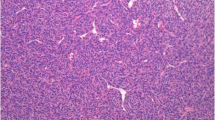Summary
Hemangiopericytomas of the meninges are rare tumors. Three tumors of this type with a course over more than 10 years each are reported. All three tumors were primary diagnosed as meningiomas (one: vascular, two angioblastic). The diagnosis was changed to hemangiopericytoma only then when recurrences and extracranial metastases had occurred. Morphologically, “angioblastic meningioma” and “hemangiopericytoma of the meninges” show striking common features. The principal pattern bases on the blastomatous increase of capillary blood vessels lined by a normal endothelium, extracapillary proliferation of pericyte-like mesenchymal cells and an intercellular network of reticulin fibres. Light- and electron microsopic findings do not demonstrate the characteristics of a meningioma. Furthermore, clinical data and growth pattern of “angioblastic meningioma” and “hemangiopericytoma of the meninges” are well comparable. Therefore, it seems to be justified to interpret these tumors as a tumor entity with identical histogenesis. It is well known that hemangiopericytomas frequently recur and metastasise. On the other hand, meningiomas are usually benign. For those reasons we suggest that these tumors should be uniformly classified as “hemangiopericytoma of the meninges” in order to stress the significance of these particular tumors of the meninges regarding their treatment and behaviour.
Zusammenfassung
Hämangiopericytome der Meningen sind selten. Es wird über drei derartige Tumoren mit einem jeweils über 10 Jahre währenden Beobachtungszeitraum berichtet. Primär erfolgte die Klassifizierung in allen Fällen als Meningeom (1mal gefäßreich, 2mal angioblastisch). Erst nach z.T. mehrfachen Rezidiven sowie extracranieller Metastasierung in zwei Fällen wurden die Diagnosen revidiert und die Tumoren als Hämangiopericytom aufgefaßt.
Morphologisch zeigen „angioblastisches Meningeom“ und „Hämangiopericytom der Meningen“ auffällige Gemeinsamkeiten. Das fundamentale Baumuster beruht auf der blastomatösen Vermehrung capillärer Blutgefäße mit normaler Endothelauskleidung, extracapillär proliferierter mesenchymaler Zellen vom Typ der Pericyten und einem intercellulären Netzwerk reticulärer Fasern. Die erhobenen licht- und elektronenmikroskopischen Befunde zeigen nicht die typischen Merkmale eines Meningeoms. Da zudem Klinik und Wachstumsverhalten von „angioblastischem Meningeom“ und „Hämangiopericytom der Meningen“ vergleichbar sind, erscheint es gerechtfertigt, diese Tumoren als einheitliche Geschwulstform mit gemeinsamer Histogenese anzusehen. Wegen der bekanntermaßen hohen Rezidiv- und Metastasierungsrate des Hämangiopericytoms einerseits — im Gegensatz zu der Gutartigkeit der üblichen Meningeome andererseits — halten wir es für sinnvoll, diese meningealen Tumoren einheitlich als „Hämangiopericytom der Meningen“ zu bezeichnen, um hinsichtlich des therapeutischen Vorgehens und prognostischer Aussagen die Besonderheit dieser meningealen Tumorform hervorzuheben.
Similar content being viewed by others
Literatur
Bailey, P., Cushing, H., Eisenhardt, L.: Angioblastic meningiomas. Arch. Path. 6, 953–990 (1928)
Battifora, H.: Haemangiopericytoma: Ultrastructural study of five cases. Cancer (Philad.) 31, 1418–1432 (1973)
Begg, Ch.F., Garett, R.: Hemangiopericytoma occuring in the meninges. Cancer (Philad.) 7, 602–606 (1954)
Bland, J.O.W., Russel, D.S.: Histological types of meningiomata and comparison of their behaviour in tissue culture with that of certain normal human tissues. J.Path. Bact. 47, 291–309 (1938)
Bommer,G., Altenähr,E., Kühnau,J.jr., Klöppel,G.: Ultrastructure of hemangiopericytoma associated with paraneoplastic hypoglycemia. Z. Krebsforsch. (1976), im Druck
Cervos-Navarro, J.: Elektronenmikroskopie der Hämangioblastome des ZNS und der angioblastischen Meningeome. Acta Neuropath. 19, 184–207 (1971)
Corradini, E.W., Browder, J.: Angioblastic neoplasms of the brain. J. Neuropath. exp. Neurol. 7, 299–308 (1948)
Hahn, M.J., Dawson, R., Esterly, J.A., Joseph, D.J.: Hemangiopericytoma. An ultrastructural study. Cancer (Philad.) 31, 255–261 (1973)
Heckmann, K.: Beitrag zur Pathologie seltener Angiosarkome der Orbita: Hämangiopericytom und Hämangioendotheliom. Ophthalmologica (Basel) 166, 36–47 (1973)
Jeffreys, R.V.: Supratentorial haemangioblastoma. Actaneurochir. 31, 55–65 (1974)
Kernohan, J.W., Uihlein, A.: Sarcomas of the brain. Springfield, Ill.: Charles C.Thomas 1962
Kuhn, Ch. III., Rosai, J.: Tumors arising from pericytes. Ultrastructure and organ culture of a case. Arch. Path. 88, 653–663 (1969)
Kruse, F. jr.: Hemangiopericytomata of the meninges (Angioblastic meningioma of Cushing and Eisenhardt). Neurology 11, 771–777 (1961)
Muller, J., Mealey, J. jr.: The use of tissue culture in differentiation between angioblastic meningioma and hemangiopericytoma. J.Neurosurg. 34, 341–348 (1971)
Murad, T.M., v. Haam, E., Murthy, M.S.N.: Ultrastructure of a hemangiopericytoma and a glomus tumor. Cancer (Philad.) 22, 1239–1249 (1968)
Napolitano, L., Kyle, R., Fisher, E.R.: Ultrastructure of meningiomas and the derivation and nature of their cellular components. Cancer (Philad.) 17, 233–241 (1964)
O'Brien, P., Brasfield, R.D.: Hemangiopericytoma. Cancer (Philad.) 18, 249–252 (1965)
Ramsey, H.J.: Fine structure of hemangiopericytoma and hemangioendothelioma. Cancer (Philad.) 19, 2005–2018 (1966)
Reich, H.: Das Hämangiopericytom des Kindes. Mschr. Kinderheilk. 120, 430–434 (1972)
Rhodin, J.A.G.: Ultrastructure of mammalian venous capillaries, venules and small collecting veins. J. Ultrastruct. Res. 25, 452–500 (1968)
Rubinstein, L.J.: Tumors of the central nervous system. Atlas of tumor pathology. Sec. Ser., Fasc. 6. Washington, D.C. A.F.I.P. 1972
Russel, D.S., Rubinstein, L.J.: Pathology of tumors of the nervous system, 3d Ed. London: Edward Arnold 1971
Stout, A.P.: Hemangiopericytoma. A study of 25 new cases. Cancer (Philad.) 2, 1027–1054 (1949)
Stout, A.P.: Tumors featuring pericytes. Glomus tumor and hemangiopericytoma. Lab. Invest. 5, 217–223 (1956)
Stout, A.P., Murray, M.R: Hemangiopericytoma, A vascular tumor featuring Zimmermann's pericytes. Ann. Surg. 116, 26–33 (1942)
Zimmermann, K.W.: Der feinere Bau der Blutkapillaren. Z. Anat. Entwickl.-Gesch. 68, 29–109 (1923)
Zülch, K.J., Christensen, E.: Pathologie der raumbeengenden intrakraniellen Prozesse. In: Handbuch der Neurochirurgie, Bd. III (Hrsg.: H.Olivecrona u.W.Tönnis). Berlin-Göttingen-Heidelberg: Springer 1956
Author information
Authors and Affiliations
Additional information
Herrn Prof. Dr. med. Dr. phil. Rudolf Janzen gewidmet.
Rights and permissions
About this article
Cite this article
Kastendieck, H., Klöppel, G. & Altenähr, E. Morphologie und klinische Bedeutung des meningealen Hämangiopericytoms. Z. Krebsforsch. 85, 287–297 (1976). https://doi.org/10.1007/BF00284087
Received:
Accepted:
Issue Date:
DOI: https://doi.org/10.1007/BF00284087




